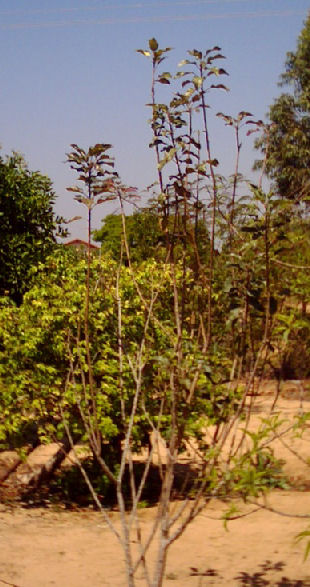

Malus domestica (Apple Tree)
The cultivated apple (Malus domestica) is a well known species from the genus Malus in the family Rosaceae. It is an economically important kind of fruit. The fruit of the apple tree is called apple. Apples are grown both as a food in the orchards as well as for ornament. In addition, an effect attributed to them as a remedy. When the fruit simply symbolize the apple and the apple tree, the enviroment, sexualitiy issues, fertility and life, knowledge and decision-making and wealth.
The cultivated apple is a deciduous tree that forms a tollfree stand at around 28 to 45 feet tall, wide sweeping treetop. In fact, this habit is rarely observed, since the different varities in conjunction with their documentation which is often highly variable in height (show as extreme cases of high trunk and the spindle bush), which also by the cut does not come to expression. The alternate leaves are arranged oval to ovate or elliptic, usually serrate, rarely lobed, sometimes entire margins. The wood of the cultivated has a light red sapwood and a reddish-brown core. It is hard and heavy and is one of the hardwoods in Europe. The best ones give the huge trunks of the cider apple trees. 20
The flowers appear singly or in bunchy inflorescences. The fivefold, radiating flowers are semi-double or filled at a few varieties, mostly shallow cup, often fragant, and they usually have a diameter of 1.8 to 2 inches. The five petals are white or slightly pink, in the closed bud state always clearly reddish. Depending on the number of flower stamens and five carpels are present.
The apple blossoms in Southern Brazil in October and November. The apple blossom is a typical bee flower, which ensures the honey bee pollination.
The pulp of the apple, which is usually referred to as a fruit, not formed from the ovary, but from the flower axis. The biologist speaks therefore of apparent fruit. The apple fruit - the apple is the typical - is a special form of collect follicle. A bellows consists of a carpel, which grows together with a seam with itwself. Within the pulp producted from the fruit bellows-like leaf a parchment package. In the pulp itself is more than the few isolated stone cell nests.
Apples ripe after the harvest. As enclosed apple and a cover to bananas and other fruits ripen faster. The reason is the gaseous plant hormone ethane, which is released during degreening. Because of the enzymatic browning, the fruit is there, where is not protected by the shell, brown at different speeds depending on the variety. This is safe, but that affects the medical curative effect. When eaten raw, the core material is generally disdained. It is often said that apples are not be eaten whole, as their seeds contain cyanide. The hydrocycanic acid content of apple seeds is very small and therefore safe to eat from whole apples.
The cultivated apple is a bred form, which is formed after recent speculation by crossing the wild today in Europe still occurring wood apple (Malus sylvestris) with Malus praecox and/or Malus dasyphylia. Recent genetic studies indicate, however indicate a descent from the Asian wild apple (Malus sieversii) crosses the Caucasus apple (Malus orientalis). The three aforementioned wild apple varieties are probably already crossed fairly early. The original origin of the cultivated apple may be found in Asia. How and when it came to Central Europe, is not known. The most likely option is to spread trade routes, because the fruit was regarded since early times as life-prolonging medicine. To Brazil and South America it came through German, Portuguese and Spanish colonists. The apple is grown in South America, particularly in Argentina, Chile and also in the southernmost states of Brazil, especially in Rio Grande do Sul, Santa Catarina and in Paraná, as the frost is absent in our garden, our apple trees lose their foliage only partially, put their winter dormancy in the dry season in the southern winter, the day length in the southern winter in our region is only slightly shorter, the shortest day lasts 11 hours. Apparently the apple is one long-day-plant.

One of our apple trees in September 2008.
Back to the Agricultural Plant List
Created by Joachim Jaeck on December 1st, 2009